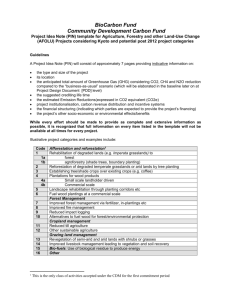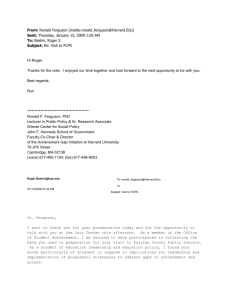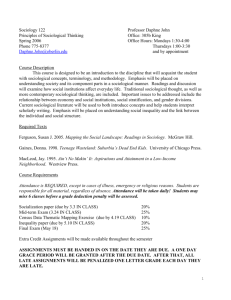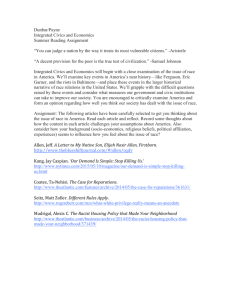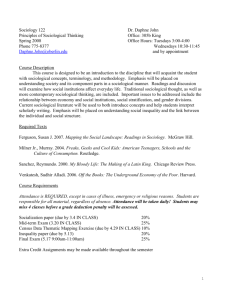04_MIPS_ISA
advertisement
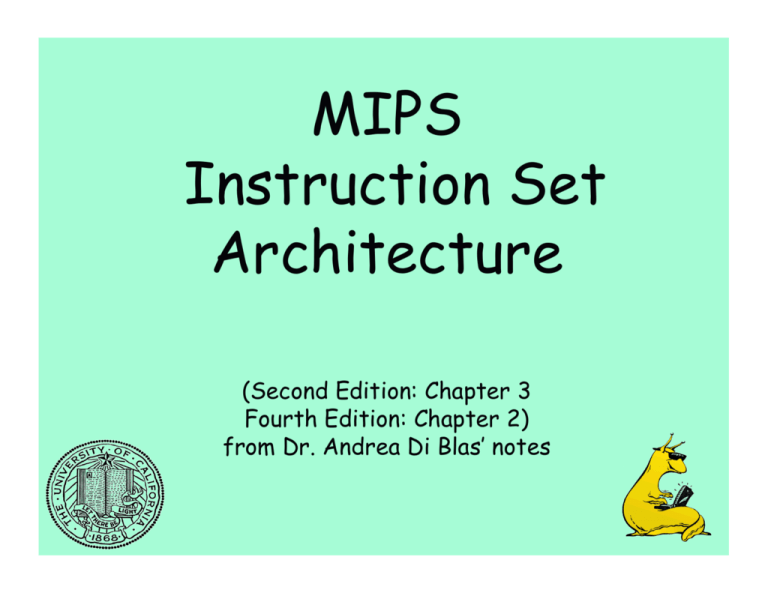
MIPS Instruction Set Architecture (Second Edition: Chapter 3 Fourth Edition: Chapter 2) from Dr. Andrea Di Blas’ notes Instruction Set Architectures • What is the ISA • Types of ISA – Accumulator Architecture – General Purpose Architecture • Memory Operands • Register Operands (Load/Store) • MIPS ISA CMPE 110 – Spring 2011 – J. Ferguson 4-2 Instruction Set Architecture • Definition 1: The interface between a computer’s software and its hardware. • Definition 2: A computer’s Assembly Language • Advantage: Allows different computer types (with the same ISA) to run identical software. CMPE 110 – Spring 2011 – J. Ferguson 4-3 ISA - Specifics ISA is all of the programmer-visible components and operations of the computer. – memory organization • address space - how may locations can be addressed? • addressability - how many bits per location? – register set • how many? what size? how are they used? – instruction set • opcodes • data types • addressing modes The ISA provides all the information needed for someone to write a program in machine language (or translate from a high-level language to machine language). CMPE 110 – Spring 2011 – J. Ferguson 5-4 Basic ISA Types – based on Operands • • • • A, B, C are operands in A+B = C Stack Architecture – no explicit operands Accumulator Architecture – one explicit operand General Purpose Register Architectures: 3 explicit operands – Memory-Memory – Register-Memory – Register-Register CMPE 110 – Spring 2011 – J. Ferguson 4-5 Stack Architecture 0 explicit operands. All operands on Stack. A = B * (C + D * B) 1. Push B 2. Push D 3. * 4. Push C 5. + 6. Push B 7. * 8. Pop A CMPE 110 – Spring 2011 – J. Ferguson 5 SP 0. 2. 4. 5 5 4 4 D 4 3 3 B 2 V3 5 C 8. 4 B 3 DB 3 A 2 V3 2 V3 2 V3 1 V2 1 V2 1 V2 1 V2 0 V1 0 V1 0 V1 0 V1 4-6 Accumulator Architecture One explicit operand per instruction. Other two are (1 source, 1 destination) are in the Accumulator. A = B * (C + D * B) 1. 2. 3. 4. 5. Load B Mult D Add C Mult B Store A CMPE 110 – Spring 2011 – J. Ferguson ex operand ALU accumulator 4-7 GPR Architecture: RegisterMemory Two Operands: a Register (for one source and destination) and a memory location. A = B * (C + D * B) 1. 2. 3. 4. 5. Load R0, B Mult R0, D Add R0, C Mult R0, B Store R0, A CMPE 110 – Spring 2011 – J. Ferguson Memory or registers ALU registers 4-8 GPR Architecture: MemoryMemory Three Operands, each can be from a register or from memory. A = B * (C + D * B) 1. Mult R0, D, B 2. Add R0, R0, C 3. Mult A, B, R0 CMPE 110 – Spring 2011 – J. Ferguson ALU 4-9 GPR Architecture: Register – Register (Load/Store) Three Operands, each must be from a register. Load and Store to move data memoryregisters A = B * (C + D * B) 1. 2. 3. 4. 5. 6. 7. Load R0, B Load R1, D Mult R2, R0, R1 Load R3, C Add R3, R3, R2 Mult R4, R0, R0 Store R4, A CMPE 110 – Spring 2011 – J. Ferguson ALU registers 4 - 10 Comparison of GPR Arch. • Memory-Memory (DEC VAX) – Fewest instructions – Most memory accesses (up to 3 data accesses per instruction) • Register-Memory (PDP-11, IBM 360, i80x86) – 1-2 data memory accesses on average – Smaller code size – Variable instruction length • Load/Store Register-Register – Fewest data memory accesses – Simple code generation – Simpler to Pipeline! CMPE 110 – Spring 2011 – J. Ferguson 4 - 11 Advantages for each ISA type • Stack Arch. – No need to have explicit operands. (ALU instructions simpler) • Memory-Memory GPU Arch. – Very flexible, fewer instructions to execute program. • Accumulator and Reg-Mem GPU Arch. – Only one explicit operand. Fewer data memory accesses • Load/Store (Reg-Reg GPU) Arch. – Flexible once in registers, fewer data memory accesses, designed for pipelining. CMPE 110 – Spring 2011 – J. Ferguson 4 - 12 RISC type of Register-Register GPU Reduced Instruction Set Computer (RISC) research • Many complex instructions were seldom, if ever, used in compiled code • In some cases more, simpler instructions were faster than fewer, complicated instructions. • Microinstruction pipelining techniques could be applied to processors if instructions were changed. CMPE 110 – Spring 2011 – J. Ferguson 4 - 13 RISC design principles • Make the common case fast. • Smaller is faster – Design easier to optimize – Distance increases propagation delay. • If it is expensive to implement in hardware, maybe it should be implemented in software instead. • Simplicity favors regularity CMPE 110 – Spring 2011 – J. Ferguson 4 - 14 RISC architecture characteristics • Fixed size instructions (for easy pipelining and decoding) • Memory transactions allowed only in separate Load and Store instructions (for easier pipelining) • Few and simple addressing modes • Large orthogonal register sets (no/few special registers) • No/few complicated instructions CMPE 110 – Spring 2011 – J. Ferguson 4 - 15 Microprocessor without Interlocked Pipeline Stages (MIPS) • Company founded by Hennessey and others in 1984 to build a commercial RISC processor. • Bought by Silicon Graphics and is now MIPS Technologies • Processors used by Sony, Nintendo, etc. CMPE 110 – Spring 2011 – J. Ferguson 4 - 16 Units of Data • • • • • • BIT: one binary digit (0 or 1) BYTE: an 8-bit binary string NIBBLE or NYBBLE: a 4-bit binary string WORD: a string of n bits, where n is ISA dependent DOUBLEWORD: an ordered set of 2 words QUADWORD: an ordered set of 4 words CMPE 110 – Spring 2011 – J. Ferguson 4 - 17 Our MIPS • 32 bit architecture: word length, address length. • 32 General Purpose Registers: very generous in 1984. • Instruction set function: – Computational (uses ALU): and, or, add, etc. – Memory Access: lw, lb, sw, sb – Program flow • Instruction set format: – R-type – I-type – J-type CMPE 110 – Spring 2011 – J. Ferguson 4 - 18 R-type (register) Format op 31 6 bits rs 26 25 rt 21 20 5 bits 5 bits rd 16 15 shamt 11 10 5 bits funct 65 5 bits 0 6 bits • op (opcode): basic operation of instruction – also determines format – op = 0 for all R-type instructions • rs: first source operand • rt: second source operand • rd: destination • shamt: shift amount • funct: function variant (e.g. add and sub same op, but add has funct=32 and sub has funct=34 CMPE 110 – Spring 2011 – J. Ferguson 4 - 19 R-type Instructions examples: add Rd,Rs,Rt sub Rd,Rs,Rt or Rd,Rs,Rt ; Rd = Rs + Rt add $3,$17,$3 MEANING comp $17 $18 $3 - add Decimal 0 17 18 3 0 32 Binary 00 0000 1 0001 1 0010 0 0011 0 0000 10 0000 Hex 00 11 12 03 00 20 CMPE 110 – Spring 2011 – J. Ferguson 4 - 20 I-type (immediate) Format op 31 6 bits rs 26 25 rt 21 20 5 bits 5 bits offset/immediate 16 15 0 16 bits • op (opcode): basic operation of instruction (e.g. lw opcode = 35, addi opcode = 8, beq opcode = 4) • rs/base: register containing source operand or base • rt: destination register for addi or loads, source register for stores, second operand for beq • offset/immediate: immediate field in computation instructions, byte address offset (wrt rs) in load/store instructions, word address offset (wrt PC) in branch instructions – always sign extended to a 32-bit value. CMPE 110 – Spring 2011 – J. Ferguson 4 - 21 I-type Instructions examples: addi Rd,Rs,N ori Rd,Rs,N beq Rs,Rt,Label lw Rt,N(Rs) sw Rt,N(Rs) ; Rd = Rs + SignExt(N) ; Rd = Rs | SignExt(N) ;If(Rs == Rt) goto Label ;Rt = Mem[Rs + SignExt(N)] ;Mem[Rs + SignExt(N)] = Rt addi $8,$22,-16 MEANING addi $22 $8 -16 Decimal 9 22 8 -16 Binary 00 1001 1 0110 0 1000 1111 1111 1111 0000 Hex 09 16 08 FFF0 CMPE 110 – Spring 2011 – J. Ferguson 4 - 22 J-type (jump) Format op 31 target 26 25 6 bits 0 26 bits • op (opcode): basic operation of instruction (e.g. j opcode = 2) • target: target word address of the instruction to jump to. CMPE 110 – Spring 2011 – J. Ferguson 4 - 23 J-type Instructions examples: j Label Jal Label ; goto Label ; $31 = PC+4, goto Label MEANING j Decimal 2 Binary 00 0010 Hex 2 CMPE 110 – Spring 2011 – J. Ferguson Label (part of) Label’s address 4 - 24 R-, I, and J-type format comparison R-type: op 31 rs 26 25 rt 21 20 rd shamt 16 15 11 10 funct 65 0 I-type: op 31 rs 26 25 rt 21 20 offset/immediate 16 15 0 J-type: op 31 target 26 25 CMPE 110 – Spring 2011 – J. Ferguson 0 4 - 25


